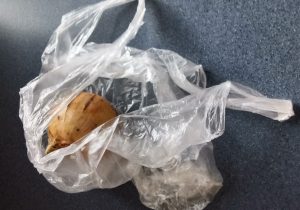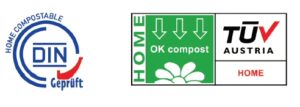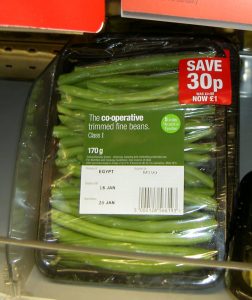Food and packaging
Food and packaging
8/02/25
Things that you can do to green your purchases
- Reduce the amount of meat you buy
- In restaurants, tell staff if portion sizes are too big
- Use tap water rather than bottled water at home, work and during sport
- Don’t buy multi-packs; buy single packs and dispense from these
- Minimise purchase of sugary, carbonated drinks
- Minimise purchase of over packaged foods
- Buy biodegradable packaged foods whenever possible, be they plastic or paper
Food, drink and its packaging
The food you buy, the packaging it comes in and how far it travels, all influence the energy used in producing food for your table.
Energy content of food
The main metric used in evaluating the energy used in food production is its Energy Output / Input Ratio. This is the food energy produced (kJ/kg) divided by the fossil fuel and electric energy used per kg to produce the food (Tractor power, sprays, fertilizer, transport, etc). For crops, more energy is produced than used, due to most of their energy coming from the sun. The food input energy is often referred to as its carbon footprint.
A vegan diet has a low carbon footprint, a vegetarian has a medium footprint while a meat diet has the greatest carbon footprint, due to the inefficiencies involved in the conversion of grass and cereals into meat. Since our bodies needs both energy (from carbohydrates) and protein (from pulses, vegetables, milk products and meat), vegans and vegetarians need to ensure they eat sufficient protein to stay healthy. People in the UK who eat meat usually have an excess of protein in their diet.
To achieve both a healthy and a low carbon footprint diet, meat eaters should eat meat in small quantities, using its strong taste to enhance the flavour of food. Low meat content dishes like pasta, pizzas, vegetable stews, pies, soups, home-made sandwiches, all accompanied with vegetables, salad and potatoes or pasta make for a balanced diet.
While hill grazing might seem a good way to utilise poor land, it takes almost twice as long to fatten hill cattle compared to those in a feed lot. Their methane production is therefore significantly higher than more intensively fed beef. Growing trees rather than feeding livestock is probably a better way of utilising hill land.
Minimally processed food
The food industry is very clever at delivering products that maximise the income it can extract from you, the shopper. Some of this has a benefit for you; some has little or none.
Examples are: –
- Quick-cook dried foods such as rice, pasta, dried fruit, etc. By having higher levels of moisture in these products, they cook quicker. Items like prunes or apricots need enhanced plastic packaging to preserve them at high moisture contents. Boil in the bag rice is sold in nylon bags which are not recyclable. These high moisture products mean you are paying extra for added water.
- Pre-prepared foods like lasagne, shepherd’s pie, Indian dishes, are made to a price. Salt and additives with e-numbers enhance the taste of often low-quality meats and extend shelf life. In addition, the container may not be recyclable. While convenient for occasional use, buying basic ingredients without the salt and e-numbers, will give better value and a better diet.
Packaging
Nowadays in supermarkets, almost everything is wrapped in plastic. This allows rapid filling of trolleys, extends food shelf life, prevents customers “cherry picking” individual pieces of fruit or veg., and protects delicate items from being damaged on the way home.

The only way to avoid excessive packaging is to avoid multi- wrapped packs. Where items like fruit, vegetables, bakeries are sold unpackaged, they generally require customers to fill a flimsy plastic bag or window-paper bag, which are neither recyclable nor compostable. A better option is for customers to take and fill reusable white mesh bags, which can be reused time and time again.
By avoiding multipacks, such as individual juice cartons, separately wrapped sweets, etc, packaging waste will be minimised. In Aberdeen’s Materials Reclamation Facility (MRF), Tetra Pak cartons are sent for “recovery” (i.e. burning) in Scandinavia, so these are not very environmental. Which magazine states that Tetra Pak are unrecyclable.
The big user of packaging is carbonated drinks and beers. If you avoid these, the contents of your recycling bin will be kept to a minimum and your waistline preserved. Getting milk delivered in glass bottles will also shrink your recycling bin contents, but at a cost. Our milk, delivered three times a week in glass bottles, costs £0.94 a pint compared to £ 0.65 a pint at the supermarket.
Where possible choose paper packaging over plastic, such as in egg boxes, as they can either be recycled or composted. Flimsy clear-polystyrene boxes for croissants, meringues, are not recycled.
Biodegradable films and trays
Two issues are being hotly debated at present, the amount of fresh food being wasted, and the pollution caused by oil-based plastic films. A large part of the solution to both is the development of biodegradable packaging.
The use of plastic film (bags) compared to paper packaging (bags) plays an important role in minimising moisture loss from, bread, baking, crisps, raspberries, grapes, etc. This keeps food fresh and minimises waste. However, plastic film is not worth recycling into new plastic as it contains polymers that are often incompatible, has strong colours, and is uneconomic to separate and clean (Pringle and Barker, 2004, Bibliography). When discarded it does not break down, leading to unsightly road verges and in the worst cases, to drains and rivers choked with garbage.
Stop Press: If you are concerned about plastic litter and want a sustainable solution, go to the recent post “Biodegradable plastic film for sustainable disposal”.
While plastics manufacturers will defend the use of oil-based plastic films with often questionable claims, I believe the demise of oil-based film manufacturers is inevitable unless they change to producing biodegradables. All organic materials on earth are biodegradable; oil-based plastics are not. Society must move to using materials that are either worth recycling or biodegradable.
There is a race being played out by chemists and companies developing biodegradable plastics that have the moisture retaining properties of conventional plastic films. These are made from maize starch, potatoes, sugar cane, and a host of other natural products. These can be digested by fungi, bacteria, and soil-based animals, to create organic nutrient in the form of fertiliser for plants to take up to grow on for food.
Biodegradable film and tray manufacturers produce packaging to two different standards, one for composting in industrial-type in-vessel containers, at a temperature of 70°C. The other type decomposes in garden compost heaps, at 0-25°C. Since a proportion of biodegradable plastic film will be discarded as litter, the low temperature rotting that will occur in waste on road-verges means that only the home compost standard is acceptable if litter made of this material is to decompose.

Vegware, an Edinburgh based supplier of biodegradable cups, trays, bags and cutlery, say their products are mostly suitable for industrial composting or anaerobic digestion. This requires cafes, restaurants and take-aways to have contracts with industrial waste treatment companies to take used cups, trays and packaging for composting or anaerobic digestion. Some of their products are however suitable for home composting, see logos opposite. Obviously, their paper products compost well, so long as they are shredded first to help the digestion process. PlasticFri, a Swedish based supplier, appear not to need the high temperature composting process to process their products.
Magazine publishers are showing food producers the way forward, by sending out their magazines in compostable plastic sleeves or paper envelopes. I put these in my New Zealand style compost bins, and after some early failures to decompose, the latest versions all seem to degrade in three months. These included the RSPB magazine Nature’s Home, Potato Review, and the Rohan catalogue. The Co-op’s new biodegradable carrier bag decomposed well, although it took Ian Ferguson, the Co-op’s packaging manager, nine years to change his mind about compostable plastics! For best results, chop up the packaging, so that it becomes well mixed with the food waste and so gives the micro-organisms a balanced diet. Hopefully food producers will follow publishers example and more from oil based plastic to plant based material.
A last benefit from compostable packaging is that it can be used as a feedstock to create either compost or biogas. Like any organic feedstock in a sealed chamber, it will produce methane, which can be used to drive a generator, fuel vehicles, or be piped to homes to heat buildings. Biogas does not contribute to global warming, unlike natural gas, (can you explain why?), so is a useful form of heating or vehicle fuel.
An issue to be resolved is how to identify biodegradable from oil-based plastic film. This is important if a waste processor is trying to recycle plastic film, as any biodegradable material will introduce weakness into the plastic. The compost label will help here. As more compostable packaging comes on to the market, composting or AD will become the normal disposal route for food packaging, so identification will become less of an issue.
Chilled storage
Over time foods become invaded with moulds and bacteria that produce toxins, which are harmful to us. They can cause anything from vomiting and diarrhoea to food poisoning. The rate of growth of these organisms is a time-temperature relationship. The higher the temperature and the longer the time, the more infection there will be.
Foods remain safe to eat for longer at 5°C fridge temperature than at room temperatures. At freezer temperatures of -18 °C, decay is stopped altogether.
To minimise waste, foods are usually best stored chilled in the fridge, or frozen in the freezer. Food left over from meals can be put in plastic containers with lids or bags and put in the freezer. The food is best stored in usable portions, so that only the required amount needs to be warmed prior to use.
While fridges keep food cool, they also dry out the air surrounding the food. Ham left uncovered on a plate will dry and curl. Keeping refrigerated food in containers or sealed dishes prevents food drying out.
Best before (BB)
Food now usually comes with “best before” dates on the packages. These are approximate recommendations as to when food should be eaten. A degree of judgement can be used to assess whether the food is safe to eat.
Most care needs to be taken with meats, fish, cheeses, soups and half used cans or pots of meat and yogurts. Food producers must err on the safe side, so food may still be suitable to eat after the “BB” date. In choosing to eat items after the “BB date, you should check the contents. Smell of meat is one indicator of decay. Slime between the meat and package is another. Meat, soups, yogurt, etc showing signs of pustules (circles) of moulds should not be eaten.
Moulds on cheese can be cut away but remove some of the good cheese surrounding the mould, to ensure all the mould has been removed.
Bread and dry goods will lose their freshness but usually can still be eaten. Their taste may be impaired. If the bread is damp, pin mould may develop, so items affected should be discarded.
How to minimise wasting food in the home
Minimising food waste is easily done so long as a few “rules” are followed: –
- Keep a log of what food you have in your fridge and dry goods on your mobile phone
- Make a list before shopping of what you need to buy, so that you are not distracted by enticing displays or two-for-one bargains
- When you get home, store the various items as follows: –
- Bread, rolls, croissants; put in plastic bags and seal, to minimise moisture loss
- Meat, cheese, fish, keep wrapped in plastic in the fridge
- Potatoes should be kept cool (4 – 10 °C) for long term storage in a light-proof paper sack, usually in a cellar or cool cupboard
- Carrots (and potatoes for short term storage) should be put in the fridge, but tear open plastic bags to ensure their skins dry and stay dry
- Leeks, beans, tomatoes, all can stay unwrapped in the bottom of the fridge for 3-4 days
- Lettuce should be kept in a container or plastic bags to maintain crispness
- Onions are kept in a cool dry place separate from the other food, to avoid making other food taste of onions
- Fruit, vegetables and meat in boxes or trays sealed with film are best left unopened until ready to be eaten. They usually have a modified internal atmosphere to extend their shelf life.
- Bananas should not be kept in the fridge, or they go black
Try to keep as empty a fridge as possible to prevent UFOs (Unidentifiable festering objects) lurking behind other items.
Where to discard food
Unopened cans, pots, jars, and oven ready or microwave meals will all end up in landfill if put in any residual waste bin. If you have a caddy bin, open the food container and put the contents in it. The can, tub or jar can then be recycled. Don’t empty the contents into garden composters unless these are completely vermin proof.
Stick with what is in season

Supermarkets provide a remarkable range of fruit and vegetables from all over the world. But do you need mange tout from Kenya, raspberries from Saudi Arabia or avocados from California. To avoid the carbon footprint of such travel distances, keep to winter vegetables like cabbage, Swedes, Brussel sprouts, carrots, and frozen peas, in winter and French beans.
References. The Bioeconomy Consultants NNFCC News review. Bio-based products. Issue 97 April 2020. PP 18
